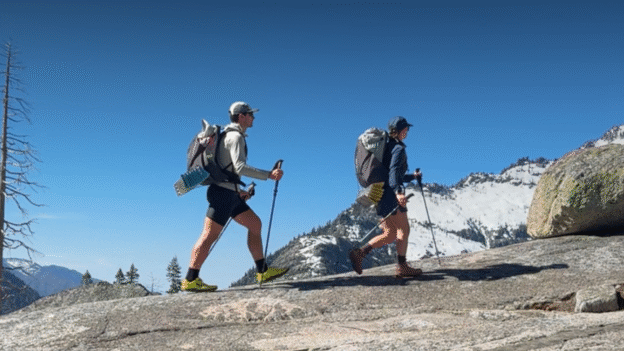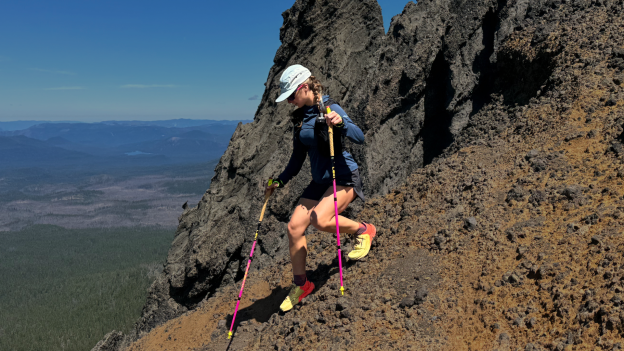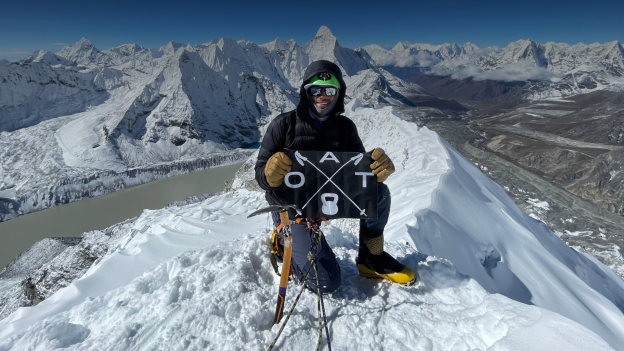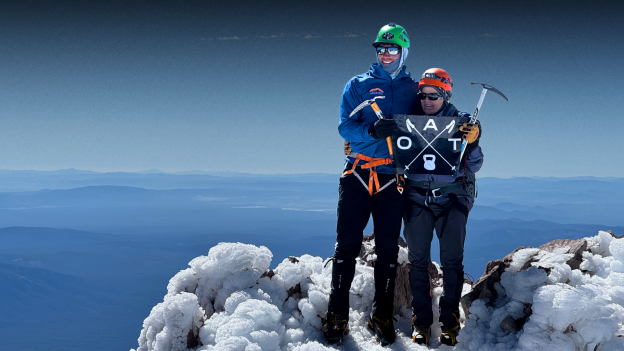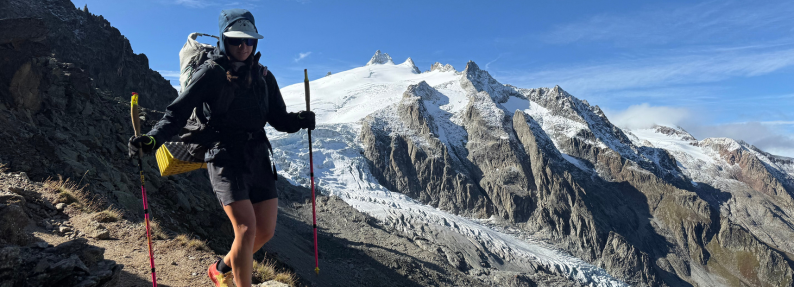Packs, Pounds & Percentages

Packs, Pounds & Percentages
Understanding and Preparing for Heavy Pack Loads in the Backcountry
We’ve seen it all when it comes to the gear junkie’s obsession with ultralight optimization: the $50 titanium spork, the toothbrush snapped in half, the same pair of socks worn for nine days straight—all to save 60 grams. Most outdoor enthusiasts will do anything to cut weight, spending hundreds to shave off a few ounces.
There’s nothing wrong with dialing in your gear. But when your objective demands a heavy pack—ropes, mountaineering gear, extra food, group supplies—no amount of retail therapy will prepare your body to carry it across rugged terrain.

Ounces Lead to Pounds Pounds Lead to Pain
On recent back-to-back traverses through British Columbia’s Coast Range, I was reminded of this firsthand. I slogged my 60-pound companion across dozens of glaciers, over steep mountain passes, and down long, technical descents. Even after a decade of sport-specific training and guiding experience, I felt the strain of the heavy pack: tight hips, tender shoulders, and the kind of fatigue that lingers for days.
In those moments deep in the pain cave, I wasn’t thinking about shaving off ounces. I was thinking about the only variable I could actually control: how I prepared.
This guide isn’t about gear hacks or the best ultralight sleep system. It’s about how to train your body to handle the weight you can’t avoid—through science-backed programming, smart progressions, and a better understanding of what your body is actually managing in the backcountry.
Let’s break down the numbers, unpack the risk factors, and show you exactly how to train for your next objective—whether it’s a multi-day trek, a glacier expedition, or your heaviest trip yet.

“Cutting Toothbrushes” in Squamish, BC.

Preparing to ski down the Trorey Glaciers on the Spearhead Traverse
Don't Pack Your Fears
A question we hear all the time from mountaineers and backpackers: “How much should my pack weigh?”
But that question—on its own—isn’t all that helpful. It’s like asking, “How much weight should I lift in the gym?” The answer always depends.
Because when it comes to load carriage in the backcountry, it’s not about the raw number on the scale—it’s about how that load relates to your body, your fitness, and the demands of the terrain.
The Simple Equation:
Pack Weight % = (Pack Weight ÷ Body Weight) × 100
This percentage is one of the most useful tools we have to assess stress, strain, and fatigue risk in the mountains. It tells us how much load your body is actually managing—not just how much gear you’re carrying.

How to Use This Equation
The chart below shows how your pack weight compares to your bodyweight, helping you estimate the relative strain you’re placing on your body during backcountry travel.
To use it, find your bodyweight in the left column, then follow that row to the right until you match your estimated pack weight. The number in that cell is the percentage of your bodyweight you’re carrying—a powerful metric to assess effort, fatigue risk, and training demands.
Why 35% is a Critical Threshold
Research and field experience consistently show that once pack weight exceeds 35% of your bodyweight, fatigue and injury risk spike sharply. At this level, even strong, well-trained athletes begin to experience:
Joint strain (especially ankles, knees, hips, and lower back)
Gait and posture compensations
Slower recovery and higher risk of overuse injuries
Whenever possible, aim to stay below 35%, especially for multi-day trips or technical terrain. If your objective requires more weight—consider redistributing group gear, improving strength capacity, or refining your packing strategy.

Real-World Example: Glacier Ski Traverses
On two recent traverses through British Columbia’s Coast Range—the Garibaldi Neve and Spearhead Traverse—our team carried between 30% and 36% of body weight over 3-day routes involving glacier skinning, bootpacking, and steep alpine terrain.
As the chart below shows, even small differences in body size or pack weight can dramatically affect the percentage load—and how hard that load hits your body.
📊 See the case study chart below to explore how real athletes experienced load differently across these routes.

What This Chart Tells Us:
On the Spearhead Traverse, Emily reduced her pack weight by just 7 lbs—but that shift brought her load percentage down by nearly 6%, moving from a high-strain zone into a more manageable range. Meanwhile, Mikey’s pack weight increased slightly, but his load percentage barely changed thanks to his larger body size and high strength-to-weight ratio. This highlights a key principle: even small changes in pack weight can make a big difference—especially for smaller athletes or those operating near the upper limits of their capacity.

On most adventures, your pack gets lighter throughout the trip. On the Garibaldi Neve Traverse, we A-Framed our skis and boots, hiking out in trail shoes for the final 3 miles due to a diminishing snowpack.

Skiing with a 60lb pack down the Overlord Glacier.
Not All Packs Are Created Equal
Two hikers, same bodyweight, same 35-pound pack. One moves efficiently through long climbs, while the other grinds it out, gassed before lunchtime.
The difference? Not the pack itself—but how well their body is prepared to carry it.
Pack weight isn’t just a number—it’s a demand. One that interacts with your strength, training history, terrain, and fatigue levels. This is why some hikers bounce back from a 10-mile day, while others feel wrecked halfway through.
Key Variables That Affect Load Tolerance
These are the performance factors that determine how your body absorbs the weight—not just how much you’re carrying:
Strength-to-Weight Ratio
A smaller athlete with strong glutes, hamstrings, and core stability can often handle more load than a larger athlete with lower relative strength.Training History
If you’ve been lifting, rucking, or hiking with weight regularly, your muscles, tendons, and connective tissue are more resilient—especially under strain.Terrain
Smooth trail? Low cost. Steep climbs, sidehilling, boulders, or technical descents? Huge multiplier on joint demand and energy output.Trip Duration
Carrying 30% of your bodyweight for one hour isn’t the same as carrying it for three days. Volume matters—and compounds.Cumulative Fatigue
Add heat, sun exposure, poor sleep, altitude, or under-fueling—and your tolerance drops fast. What feels fine on Day 1 can wreck you by Day 3 if your system isn’t prepared.
📊 We’ve summarized these in the Load Tolerance Variables chart below.

Effort Climbs Fast with Pack %
The heavier the load relative to your bodyweight, the steeper the physiological cost.
In the graph below, we charted how Rate of Perceived Exertion (RPE) ramps up with pack percentage—especially as you cross the 30–35% threshold.
Once you hit the red zone, the same mileage costs a lot more in terms of effort, fatigue, and recovery time.

What This Means for Your Training
Here’s the real takeaway:
You don’t need to obsess over your pack weight—you need to understand your body’s capacity to carry it.
Once you know where your tolerance stands, you can train to expand it:
→ Through progressive strength work
→ Smart rucking and hiking exposure
→ And recovery strategies that help your body adapt
Your pack weight is only half the equation. Your preparation is the other. And that’s what we’ll break down next.
What's Safe? What's Sketchy?
There’s no single “safe” number when it comes to pack weight. But after years of mountain guiding, coaching, and logging thousands of miles under load, one thing is clear: your body has limits—and certain thresholds consistently push people beyond them.
This section isn’t about setting hard rules. It’s about helping you recognize when you’re in the green zone… and when you’re creeping into red.
These thresholds help shift the conversation from:
“How much should my pack weigh?”
to
“How much load can my body sustainably carry—given my training, the terrain, and the conditions?”

What Pushes You Closer to the Red Zone?
Even well-trained hikers can struggle when the environment stacks the odds against them. These five factors most commonly shift a “manageable” load into the danger zone:
- Terrain Difficulty
A 30% pack on smooth trail might feel fine. But loose scree, snow, or off-camber descents? That same load can feel brutal—and risky. - Elevation Gain
Long, sustained climbs massively increase demand on your posterior chain, lungs, and joint stability. - Trip Duration
It’s not just how much you’re carrying—but how long. Carrying 30% for a few miles is very different than carrying it for three days straight. - Pace
Fastpacking or racing with weight drastically increases ground reaction forces and impact stress. Your joints and tendons pay the price. - Recovery & Environment
Cold temps, high altitude, poor sleep, dehydration, or low calories? They all lower your body’s resilience and shrink your load tolerance.

Are You Ready For Your Pack
Backpack weight isn’t just a number—it’s a demand. One that your joints, muscles, and nervous system have to manage with every step. So before you set off into the backcountry, the real question isn’t how much does your pack weigh? It’s:
Is your body trained to carry it?
A Few Simple Readiness Tests
These self-assessments can give you a surprisingly accurate gauge of whether your body is ready to absorb and manage a loaded adventure:
- Can you deadlift or front squat your bodyweight (or close to it)?
- Load-bearing strength starts at the foundation. If your legs, hips, and core can’t handle your own mass under control, expect trouble when you add a pack.
- Load-bearing strength starts at the foundation. If your legs, hips, and core can’t handle your own mass under control, expect trouble when you add a pack.
- Can you perform 20+ controlled step-ups on an 18″ box with a 30–40 lb pack?
- This mimics trail movement under load. Look for clean form, no knee cave, no collapsing torso.
- This mimics trail movement under load. Look for clean form, no knee cave, no collapsing torso.
- Can you hold a 30–60 second single-leg isometric under load?
- Stability and joint control are essential. Especially on uneven terrain.
- Stability and joint control are essential. Especially on uneven terrain.
Each “yes” here increases your likelihood of moving efficiently, minimizing injury risk, and enjoying the experience rather than simply surviving it.
🧭 Not Sure Where You Land?
Use our Pack Readiness Flowchart to walk through a structured decision-making pathway. It’s a simple way to assess where you are right now—and what your next training focus should be based on your goals, pack weight, and performance capacity.

Train To Avoid Pain
If you want to move well with a heavy pack, the best investment you can make is a smart, progressive strength training program.
It’s one of the most effective ways to reduce injury risk, increase muscular endurance, and build the durability required for high-mileage days under load.
This isn’t about hiking your way into shape.
It’s about building your body from the ground up—with stability, strength, and time under tension.
Strength Training
Before you ever throw on a pack, your body needs a stable foundation—anchored by neuromuscular control, joint alignment, and integrated core strength. Once that’s in place, progressive loading teaches your system how to absorb and manage force safely.
Time under tension—how long your muscles are under strain per rep—is what builds not just muscle, but resilient connective tissue: the tendons, ligaments, and fascia that protect your joints and hold your form together when fatigue sets in.
Foundational Exercises We Program at OAT
Each of these patterns mirrors what your body faces on the trail—and develops real-world strength that transfers:
- Front Squats & Deadlifts
Build total-body strength and structural tolerance to load. - Weighted Step-Ups (ideally with your pack)
Directly replicate uphill hiking under load. - RDLs, Bulgarian Split Squats, Reverse Step-Ups
Strengthen glutes, hamstrings, and single-leg control for climbs and descents. - Farmer Carries & Weighted Planks
Reinforce core engagement and anti-rotational stability under dynamic conditions. - Deadbugs, Farmer Carry, Planks
Build deep core coordination to prevent collapse and compensation on long days.
Training Notes
- Use a 2-0-2 tempo: 2 seconds down, no pause, 2 seconds up.
This maximizes control and connective tissue adaptation. - Train across multiple rep ranges:
• Muscular Endurance: 12–20 reps
• General Strength: 6–10 reps
• Max Strength: 2–5 reps @ 90%+ 1RM (only with guidance)
Max strength work is powerful—but risky when done wrong. If you’re pushing near your limit, get coaching.
Rucking
Rucking is one of the most practical and sport-specific tools for training load carriage.
It won’t replace strength training—and it’s not the same as hiking—but it bridges the gap between gym strength and mountain reality.
Why It Works
- It gets your body used to carrying load in exactly the way you’ll need to in the field.
- Your hips will get sore. Your shoulders will ache. Your posture will get tested (that’s the point).
Backpacks aren’t ergonomic. They shift. They dig. They throw off your center of gravity. Unless you’re using a tump line like a Himalayan porter, your setup will always be imperfect. Rucking trains your body to tolerate that stress before it matters most.

What Makes It Effective
- Sport-specific: You’re carrying the same gear, in the same way, under similar conditions.
- Builds tissue tolerance to friction, compression, and strain.
- Sharpens the systems that keep you upright under fatigue.
- Easy to scale: do it with your pack, a weighted vest, on hills, the StairMaster, or treadmill incline.
How to Integrate Rucking
Rucking isn’t magic. It’s a tool. Used wisely, it builds confidence and capacity under load.
Misused, it can lead to overuse injuries—especially when piled on top of fatigue.
Start small. Build gradually. Respect recovery.
You can:
- Add short rucks (20–30 min) on rest days as active recovery
- Replace 1 steady-state cardio day/week with a longer ruck
- Gradually increase pack weight and duration as your trip nears
Your body should recognize the sensation of carrying weight before your trip—not during it. The more familiar it feels, the more durable you’ll be.
The Secret Formula
The L.E.A.D. Formula: Load Estimation for Adventure Demands
Recommended Max Pack Weight = Body Weight × Strength Score × Terrain Modifier
When it comes to deciding how much weight you can safely carry in the backcountry, most advice stops at vague percentage rules. But percentages alone don’t tell the full story. Your readiness, your training, and your route all play a role.
That’s why we created the L.E.A.D. Formula—a simple but effective way to estimate your ideal pack weight based on your real-world capacity.
This isn’t theory—it’s a field-tested tool grounded in coaching data, strength benchmarks, and the realities of moving through rugged terrain.

How it Works
Body Weight
Used as the base to calculate your relative load.
→ Measured in pounds (or kg)
Strength Score
A scaling factor based on your load-carrying readiness.
→ Range: 0.2 to 0.4
Estimate your score with these benchmarks:
- 0.36–0.4 → Deadlift or front squat ≥ bodyweight for 2–3+ reps
- 0.3–0.35 → 20+ step-ups on an 18″ box with pack weight and excellent technique
- 0.2–0.29 → Still building foundational strength or returning from injury
Terrain Modifier
Adjusts for the difficulty of the route.
→ Range: 0.8 (rugged/technical) to 1.1 (smooth trail)
Example:
Let’s say you weigh 160 lbs, score 0.35 on the strength scale, and your route is moderately rugged (modifier = 0.9):
160 × 0.35 × 0.9 = 50.4 lbs
That’s your ideal upper limit for sustained travel—especially if you’re moving multiple days under load.
This formula isn’t perfect. But it’s a practical starting point—a way to think critically about your body, your gear, and the demands of your objective.
Trip Debrief
The weight on your back is only part of the story.
How your body carries it—that’s what really matters.
Pack percentage is a useful metric, but it doesn’t exist in a vacuum. Terrain, trip length, sleep, recovery, and most importantly, your training—these shape your real-world performance.
So here’s the bottom line:
Train for the adventure you want to have—not the one your body is barely ready for.
Intentional training expands what’s possible.
It builds strength before the strain, resilience before the redline, and confidence before you ever hit the trailhead.
Build Strength For Adventure
Whether you’re hiking your first multi-day trek or preparing for your biggest alpine objective yet, our science-based programs will help you carry more, go further, and feel stronger doing it.
Backpacker’s Bootcamp
A 12-week progressive strength and endurance program designed for hikers and trekkers who want to increase pack tolerance, stability, and confidence on long days.
Summit Strength
A high-level training plan built for mountaineering and alpine goals—blending structured strength, conditioning, and ruck progressions to prepare for real-world demands.
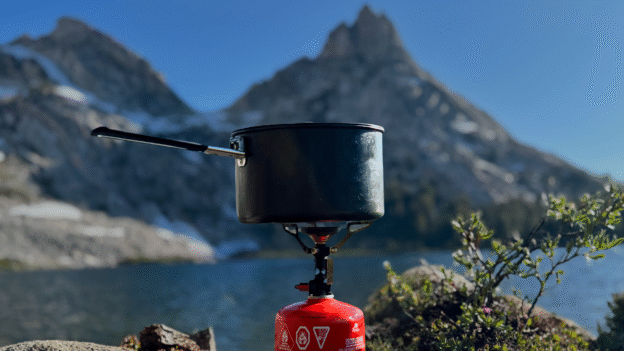
Nutrition Coaching
Performance nutrition for recovery, energy, and long-term outdoor longevity.
Learn MoreHave Questions?
We understand that starting a training program is a commitment you’re making, and we want to ensure that you get the most out of your experience with us. Ahead of registering for any of our programs, we’re available for a free 30-minute consultation to address any questions you may have.




